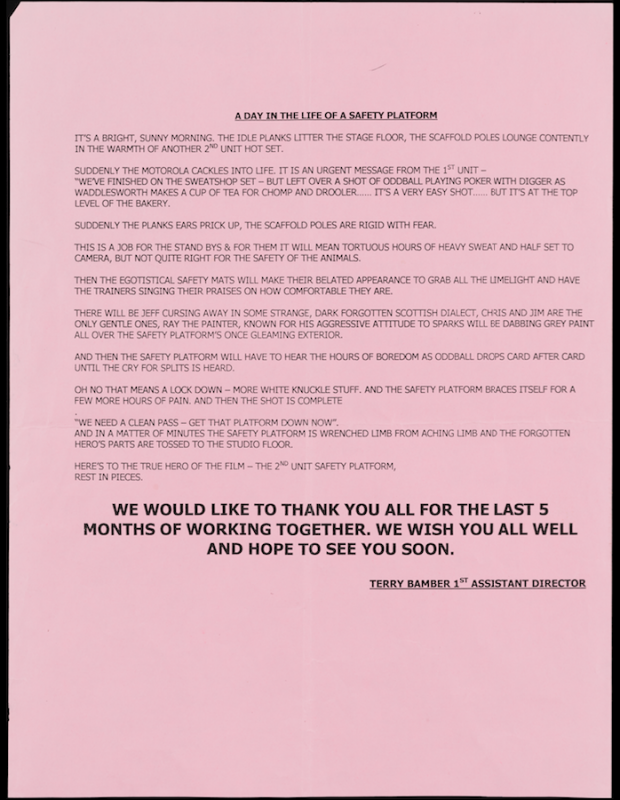Curator's Note
The Disney films based on Dodie Smith’s 1956 novel One Hundred and One Dalmatians display an obsession with reproduction. Each film links the biological with the technological, using new media to enshrine heteronormative gender roles. The 1961 animated feature displays the possibilities of animation xerography, and the 1996 “live-action” remake and its 2000 sequel attempt a digital realism that seamlessly blends the live with the computer-generated.[1]
Each film’s presentation of “nature” reaffirms the technological primacy of Disney animation, well-established since its prescient adoption of synchronized sound and Technicolor.
Yet, the gag call sheet circulated among the second unit crew of 102 Dalmatians humorously suggests the tremendous difficulties involved in disciplining physical and biological “nature” (non-human as well as human) to the standards required to project Disney’s public image of technologically progressive conservatism.[2]
While the use of technology continually re-positions Disney at the aesthetic and technical vanguard, historical time is simultaneously marked by the studio’s treatments of changing morals. The juxtaposition of humans with their anthropomorphized canine counterparts (in the 1996 wedding scene, for example, visible in the hyperlinked trailer) implies that the traditional gender binary is “natural”—inherent, inevitable, and immutable.[3] Those who deviate, as De Vil does, are presented as evil, abject, and ridiculous.
The evilness of high-femme Cruella is expressed through her vexed relation to “nature.” Her insatiable appetite for collecting and wearing the dead pelts of animals—particularly baby ones—precipitates her downfall. De Vil is a seductive middle-aged woman like other Disney witches before her. However, she is distinguished by a tendency toward slapstick comedy that undermines the threat posed by her modern independence.[4] While ingénue Anita chooses marriage over career in the 1996 and 2000 films, de Vil’s hubris costs her everything.[5] Her final appearance is covered in goo and debris in a paddy wagon, essentially paraded through town in stocks. In both, the powerful and independent de Vil is subjected to a lavishly choreographed trial by “nature” along the lines of witch burnings and dunkings.[6]
Works Cited
Federici, Silvia. Witches, Witch-Hunting, and Women. Oakland, CA: PM Press, 2018.
Merchant, Carolyn. Science and Nature: Past, Present, and Future. New York: Routledge, 2017.
[1] In addition to other Dalmatians-related animated projects for video and TV, Disney has announced that Emma Stone will star as de Vil in Cruella, scheduled for release 2021. Throughout this post, the term “nature” is in quotation marks as an acknowledgment that understandings of nature are the results of ongoing processes of social construction.
[2] From the Micky Moore Collection, Pepperdine Libraries Special Collections and Archives. Moore was Second Unit Director for both the 1996 and 2000 films.
[3] See the research of eco-feminist historian of science Carolyn Merchant on how the patriarchal gendering of nature has often coincided with the mistreatment of women as well as the natural environment. Nature has also been symbolized as an animal. Summary accounts of Merchant’s various works have recently been collected in Science and Nature: Past, Present, and Future (2017).
[4] It should be added that the representation of “unnatural” female independence as a function of wealth and waste renders invisible histories of poor and working-class feminisms.
[5] The comedy has been described in many Disney-endorsed accounts as an attempt to avoid frightening children the way earlier Disney witches had done.
[6] The tradition of Disney-fied fairy-tale witches echoes a history of witch trials expressing class elitism and misogyny leveraged on behalf of capitalist expansion and intensification. For more on this history, see the research of Silvia Federici, such as her recent book Witches, Witch-Hunting, and Women from PM Press (2018).



Add new comment